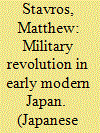| Srl | Item |
| 1 |
ID:
088112


|
|
|
|
|
| Publication |
2009.
|
| Summary/Abstract |
Exploring the specific means by which Ashikaga Yoshimitsu (1358-1408) came to dominate the most elite circles of traditional authority provides us with important clues about the nature of warrior ascendancy in premodern Japan. Scholars have considered uses of religious symbolism, various kinds of artistic patronage, and, of course, violent coercion. This essay seeks to introduce the significance of location as yet another means by which warriors, Yoshimitsu in particular, sought to elevate their status. There was a clear relationship between location and status in premodern Kyoto and Yoshimitsu carefully exploited it for the sake of advancing his political career. How plots of land had been used in the past and who had used them appear to have contributed to notions about a site's 'locational pedigree'. Acquiring and occupying sites that possess elite locational pedigree enabled Yoshimitsu to emulate outstanding historical figures and, in so doing, elevate his own status. In terms of its potential to empower, location, it is argued, might well be categorized along with ceremony, language, and architecture as a key performative element that was employed and deployed in premodern Japan to authenticate social standing.
|
|
|
|
|
|
|
|
|
|
|
|
|
|
|
|
| 2 |
ID:
124530


|
|
|
|
|
| Publication |
2013.
|
| Summary/Abstract |
Military changes that took place in Japan during the late sixteenth century bear a striking resemblance to those in Europe at about the same time. This essay argues that the Roberts thesis of military revolution - widely applied to Europe - provides a useful framework for identifying a series of cascading developments that, once realized, constituted the fundamental elements of a similar revolution in early modern Japan. These included: the almost universal adoption of firearms, the development of tactics for the effective deployment of those firearms, and finally, a change in the composition and organization of armies leading to the professionalization of warfare. Most important, by revolutionizing the way armies were organized and wars were fought, Oda Nobunaga and Toyotomi Hideyoshi contributed directly to the emergence of new notions of centralized authority that were critical to the creation of a unified and peaceful early modern state.
|
|
|
|
|
|
|
|
|
|
|
|
|
|
|
|